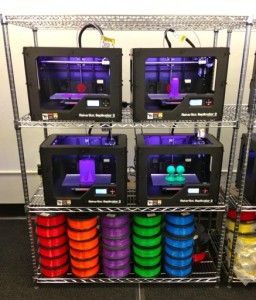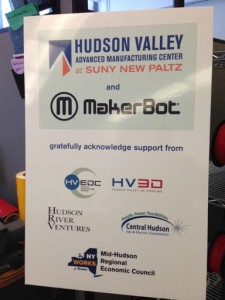MakerBot—The Brooklyn-Based Innovator In Desktop 3D Printing Equipment—Is Rapidly Pursuing Its Goal Of Parallel Innovation In The Way It Promotes It Products Commercially Via “Marketing-By-Education…”

MakerBot CEO Bre Pettis & SUNY New Paltz President Donald Christian Exchange With Press During The News Conference At The Inauguration Of The World’s First “MakerBot Innovation Center” At SUNY New Paltz, 11 February 2014.
On Tuesday, 11 February, MakerBot—what I call “The Edifying Enterprise”—continued its drive to dominate the 3DP marketplace by implementing another milestone in its Marketing-By-Education campaign. MakerBot’s CEO Bre Pettis helped cut the ribbon on the world’s first “MakerBot Innovation Center” at SUNY New Paltz, a New York State University in the Hudson Valley two hours north of the City…
3DP is the 4th Disruptor! In order of debut, these four landmarks of our Digital Age are: (1) PC; (2) Internet; (3) Social Media; (4) 3DP. Our 4th Disruptor is really about atoms not bits. Atoms make things; digits make thoughts. Disruptors (1) thru (3) are Digital; 3DP is Neo-Analog! Thus, the 3DP Revolution is fundamentally different from the first three disruptions of the last 40 years at the beginning of our Digital Age. Our Fourth Disruptor promises to help re-industrialize and rejuvenate American manufacturing—by “new-shoring” it IN the United States.
MakerBot launched its first “MakerBot Innovation Center” at a university. BUT, the company’s corporate goals are just as much about the “now!” betterment of private industry—and perhaps more so. In the world of business, MakerBot seeks to employ its 3DP means to enhance hyper-productive knowledge, instruments of innovation and change-making techniques.

One Rack of MakerBot Equipment (Of 30-Plus Machines) & Reels Of Printing Filament at the World’s First “MakerBot Innovation Center” & Its Debut Ceremony at SUNY New Paltz, 11 Feb 2014
In the strategic overview, MakerBot has a greater stake in the commercial marketplace than the educational. Businesses—startups and ramp-ups—can provide quicker ROI (with equipment purchases tomorrow). Educational institutions, conversely, will take longer to produce a return on the medium and long bureaucratic marketing and sales—of MakerBot Academies and Innovation Centers to high schools and colleges respectively.
Seeking to buttress educational institutions and the “making” careers of future graduates is strategically important to MakerBot. After all: hearts and minds make buying decisions. And, brand loyalty—so engendered—could make for lifetime-customers. It’s just that MakerBot will have to strike the right balance between the different ROI profiles of these two market segments. The quick and mercurial of business and the long-term buying profile of educational institutions.

Nancy Zimpher, Chancellor of the State University of New York, Joins The Public Ribbon-Cutting By Video Presentation At The “MakerBot Innovation Center” Debut, SUNY New Paltz, 11 Feb 2014.
MakerBot’s official media releases around the debut of the Innovation Center doesn’t specifically tout jobs as an “output” of its Centers” initiative. But, job-generation is implicit in the message the company is delivering to the marketplace.
(Note to Bre: government at every level—hamlet to Whitehouse—is seeking the Holy Grail of economic development: Job-Gen. You might as well grab this explicit position as well—politicians everywhere will love you for it AND do your marketing for you! The Chancellor of the SUNY system stated explicitly that your Center “…exemplifies the power of innovative public/private partnerships… directly connecting education, advanced technology and workforce development…”)
When we kicked off our 3DP Media startup in May of 2013, we showcased “3DP=Jobs” as one of our official mantras. And, we still do! The longform of this commercial chant is “3DP=Startups & Ramp-Ups=Jobs.” As we state in this post’s headline, 3DP’s creative making—by amateur and professional Techreatives—is the well-spring for our 21st Century’s eCottage Industries.
And, the best job-making startups will probably arise from totally naive, newbie makers—who don’t know enough to know what can’t be done. Those who can restart their creativity in the now-software and hardware modulated “playrooms” of a (virtual) childhood recaptured—where multi-media mashups, serial start-overs, laughing lunacies and sheer delight in the manipulation of 3D fun—are likely to be the most successful of the (3DP-empowered) entrepreneurs of our national makeover.

Sean Eldridge, President of Hudson River Ventures & a Founder/Benefactor of the Hudson Valley Advanced Manufacturing Center at SUNY New Paltz, exchanges with Bre Pettis, CEO of MakerBot, and keynoter at the the Grand Opening Celebration at the “MakerBot Innovation Center” at SUNY New Paltz, 11 Feb 2014.
Bre Pettis—having launched his college-based version of the “MakerBot Innovation Center”—must now figure out how to integrate a private-business version of the “Center” into the marketplace. Employing easily identified collaborators at educational institutions—to act as easy on-ramps, academic conduits and mentored path-finders—is going to be difficult enough to achieve at scale. JUST for the institution’s student population. (AND, scaling up the MakerBot Centers’ initiative—on campuses and off—in a commercial-impacting hurry is key to staying ahead of the 3DP competition.)
One solution to this dilemma—of scaling and extending the concept and reality of Innovation Centers out into each local-business community nationwide—is to partner and collaborate with ALL the hyper-local players as a TEAM of community interests.
What I’ve already started to call the Collaborative Home-Team in posts such as these.

Signage at the MakerBot Innovation Center Opening Ceremony, 11 February 2014, SUNY New Paltz, showing some of the Team of local collaborators who helped realize this break-through project.
In innovative Re-Industrialization Initiatives like this “MakerBot Center” play, there are natural allies to be recruited and conjoined into an effective local Team. The first-ever “MakerBot Innovation Center” has proved that such make-it-happen, geography-connected Teams CAN be coalesced into effective engines of common-interest, support and change. Here is my current list of possible-player categories—from which to recruit—to form such community common-good groups:
- Economic Development Organizations (e.g., Chambers, econ-dev corps, public/private partnerships, biz-improvement districts, etc.);
- Education institutions (K-12 through Graduate);
- Child-focused organizations outside school-systems (after-school, clubs, Ys, etc.);
- Local library systems;
- Community Digi/Fab-engined “makers,” tinkerers and artisans of all kinds;
- Governments and public agencies & authorities at every level;
- The local manufacturing and small-business base;
- Institutions with local or regional constituencies (e.g., banks, utilities, clubs); &
- Local or regional venture-capital firms.
These organizations have common and commonweal interests that they can naturally aggregate to advance change-agents, populations, communities, industries and more. The catalyst can be win/win initiatives like “MakerBot Innovation Centers.” BUT, the on-driving engine must be—at the least—an engaged and energetic leader (or cadre of true believers) with vision and drive to help bring such Teams together for both commerce and common-good.
Will YOU serve?!!
C’mon Back!
LAND
OBTW: 3D Systems Corp. and Hasbro Toys today announced a partnership to—as The Guardian‘s headline put it—”make 3D printing child’s play!” To quote their release, the companies are working together to “co-develop and commercialize innovative play printers and platforms later this year.” I guess Avi Reichental, 3D Systems’ President & CEO, decided to out-flank Bre by going even further down life’s food-chain—to grab “Child-Share” before MakerBot gets to “hearts & minds” in schools and colleges?! Here’s my tweet of earlier today on the topic:
@3DSYSTEMSCORP (#3DP) PLAYS W/HASBRO? @MakerBot Tgts HS & Unis; DDD 2 Transform(er) Toys: DIY Printables 4 CHILDREN! http://ow.ly/3hn3eY

 Land Grant
Land Grant  NYC3DPLand Tweets
NYC3DPLand Tweets
Pingback: How To Triumph In 3DP-Driven Economic Development: When You Witness The Start Of A (Tech) Revolution, Join With The Partisans Of Common-Good. Those Glad-Heart Guerrillas Are Gonna Win… | This Week in NYC3DP